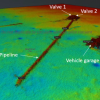Underwater operations
"HyDrone is a technology program to develop new concept underwater vehicles, highly reconfigurable with different payloads"
Categories

What is the challenge that is being addressed?
HyDrone is a technology program to develop new concept underwater vehicles, highly reconfigurable with different payloads, expected to carry out underwater missions at different degrees of autonomy and to operate resident underwater without maintenance for up to two years. Typical missions range from geographically restricted inspections and operations on wells, pipelines and processing systems (using wired communication and power), to medium range missions (based on underwater wifi communication and battery power), to long-range missions.
AI planning techniques may help to overcome several problems like:
- Management of system resources even in abnormal or unexpected conditions happening during mission execution
- Management of critical/abnormal situations that may lead to damage or risks in general
- Making the mission’s definition independent from specific field, so allowing to develop a much more general code in the lowest levels of the architecture (improving reusability, testability and development of additional features for the system and not for a specific scenario)
- Allow planning missions that foresee use of manipulator and tools in general in a seamless way with the rest of the mission
- Exploiting opportunities that may not be exploited by standard, rigid plans programmed by humans
- Help in validating missions proposed/developed by humans
What is the AI solution the project plans to implement?
In the HyDrone context, AIPlan4EU will focus on the inspection and maintenance of subsea fields, structures, and infrastructures via Autonomous Underwater Vehicles. An Autonomous Underwater Vehicle will navigate through a complex 3D map and reach an ordered set of inspection locations. While navigating, the robot will optimize resource utilization (such as time, battery charge and data capacity). Due to the unpredictable and non-deterministic nature of the underwater operating environment, it will be crucial for the robot to have replanning capabilities to adapt and adjust its path and actions due to failures or new opportunities. AIPlan4EU will model the problem as a temporal planning problem with numeric resources to be optimized (e.g., battery consumption and data storage). The AIPlan4EU planner will find the optimal path for the robot (i.e., the ordered set of targets to be reached) while optimizing numeric and temporal resources as well as handling optionality among goals. Moreover, it will handle (re-)planning requests in real-time; according to the request, it will adjust computed plans.